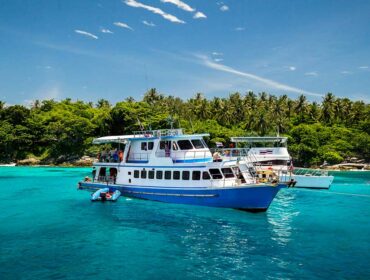Cocos Island, Costa Rica is not a dive destination for the faint hearted. If you are a true hardcore diver, and aren’t afraid of large schools of pelagic fish, Sharks and Hammerheads, and don’t mind travelling a great distance to experience some of the best shark diving in the world, then Cocos Island is just the place for you.
Situated in the Pacific Ocean a mere 550 km (340 mi) off the coast of Costa Rica and just north of the famous Galapagos Islands, Cocos is an uninhabited speck of a volcanic island with an area of 23.85 km² (9.2 mi²) rising up from the Pacific depths. Covered in lush tropical rainforest, and speckled with hundreds of waterfalls, this enchanting island served as the backdrop for the filming of the movie Jurassic Park. Both the Island and the waters surrounding it are declared a Costa Rican National Park and are protected from fisherman or visitors by Costa Rican Park Rangers.
To get to Cocos Island, the nearest airport is located in the capital of Costa Rica, San Jose. From San Jose you need to travel by bus to the Pacific coastal town of Puntarenas which is the jumping off point to the Cocos Island. From Puntarenas you have three options, all live-aboard boats since there is no accommodation or even camping allowed on the Island. The three boats permitted to conduct dive operations are the Undersea Hunter, the Sea Hunter, and the Okeanos Aggressor each well equipped dive ships with experienced dive instructors who have been diving the islands waters for years. The trip from Puntarenas on the liveaboard takes approximately 30-40 hours, but the trip is well worth it once you finally arrive.
As enchanting as the island is, the main attraction lies below the surface which is why the Cocos Island was named one of the best 10 scuba diving spots in the world by PADI and numerous other dive authorities. From the largest schools of hammerhead sharks in the World, to eagle rays, manta rays, silky sharks, Galapagos sharks, sailfish, wahoo, jacks, and the list simply goes on and on! Schooling hammerheads are usually “guaranteed” sighting, and large vortexes of pelagic fish such as jacks are so common that fish at other sites elsewhere in the world will seem to pale in comparison. Large fish and predators seem to be the theme of every dive on Cocos, and you will probably get to see almost each and every species of shark and ray during the course of your trip.
The diving off Cocos Island is meant for the more experienced diver, as currents can be strong, dive sites deep with chances of being swept away into the open waters. Liveaboard diving is usually upto 5 dives a day and Some sites often require Nitrox or experience with rebreathers to get the bottom time necessary to enjoy the sites without scaring away the hammerheads. Almost every dive site is rated as Skill Level Advanced, so make sure you have the necessary degree of comfort in your diving skills if you plan to dive here.



